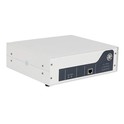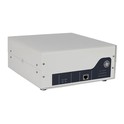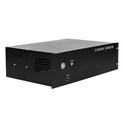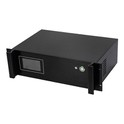Ultrasonic Homogenizer
An ultrasonic homogenizer (also referred as sonicator or ultrasonicator) is a laboratory or industrial instrument designed to disperse, mix, and break down micro/nano substances using ultrasonic energy. It operates by creating cavitation bubbles—tiny vacuum bubbles that form and collapse rapidly within a liquid medium—which generate intense shock wave, microjet and extremely high temperature and pressure. It can be used to fragment cell walls, emulsify immiscible liquids, and achieve fine particle dispersion, making ultrasonic homogenizers invaluable tools in various scientific and industrial applications.
Advantages of Ultrasonic Homogenizer
Efficiency: Ultrasonic homogenizers can achieve high-quality homogenization efficiently, enhancing productivity in both laboratory and industrial settings.
Cost Saving: Compared with conventional homogenizers, ultrasonic homogenizers are with extremley low energy consumption. They require minimal maintenance and are safe to operate, reducing downtime and operational costs.
Versatility: They are applicable to a wide range of materials, including biological samples, emulsions, suspensions, and various types of particles. This makes them useful in diverse fields such as battery, chemistry, biotechnology, pharmaceuticals, food science, and cosmetics.
Precision: Ultrasonic energy can be precisely controlled to meet specific homogenization requirements, ensuring consistent and reproducible results.
Enhanced Emulsification: Ultrasonic homogenizers are highly effective at creating stable and fine emulsions due to their ability to achieve very small droplet sizes.
Particle Size Reduction: Ultrasonic cavitation is effective in breaking down particles into smaller sizes, which is useful for applications requiring uniform particle distributions.
These advantages make ultrasonic homogenizers indispensable tools for achieving uniform and high-quality homogenization in various scientific and industrial applications.
Why Choose Us
Our Factory
The company has assembled top industry technical talents along with seasoned marketing and management professionals. Leveraging cutting-edge proprietary core technologies, it specializes in researching, developing, and selling high-performance power ultrasonic core components and related complete sets of equipment. With around 2000 square meters of research and production facilities, the company possesses a well-equipped testing center capable of conducting more than 120 types of tests in six categories.
Our Certificate
National high-tech enterprise; GB/T19001-2016/ISO9001:2015 quality management system certification; 23 patents and 3 software copyrights granted.
Production equipment
Three-axis machining center, CNC lathe, high-temperature aging furnace, ultrasonic component analyzer, high-precision oscilloscope, power analyzer, cavitation intensity measurement instrument, spectrum analyzer, laser particle size analyzer, digital bridge, infrared thermal imaging instrument, microscope, laser vibrometer, etc.
Production market
The company's products are widely used in various industries such as new materials, fine chemicals, automotive, and new energy. Since its establishment, it has achieved cumulative sales of over 45 million RMB.
Ultrasonicator devices are indispensable in research and production settings. Note that such devices can be divided into bath sonicators and probe sonicators. Bath sonicators are ultrasonic tools that spread energy diffusely, making them invaluable for the processing of large volumes, cleaning, sterilizing, and degassing. As bath sonicators do not require a lot of power, they are more durable and affordable units. That said, bath sonicators can’ t be employed for small particle sizes, and due to the uneven energy they produce, they do not support replication.
Probe sonicators, on the other hand, allow the particles around the probe to be blasted with high levels of energy, which is ideal for size reduction, cell disruption, emulsification, and dispersion of nanoparticles. Note that these devices are also called cell disruptors and ultrasonic homogenizers. Even though probe sonicators are highly sophisticated units (usually more costly than bath sonicators), we should note that erosion of the probe tip might lead to cross-contamination.
Parts of Ultrasonicator

Generator
It is one of the essential parts of the sonicator that helps to convert electrical power into an electrical signal to control the transducer. The generator consists of various keypads or nobs that allow it to adjust multiple parameters required during sonication.

Converter
It is also known as a transducer. Because of the properties of the intrinsic piezoelectric crystals, the converter converts electrical signals into high-frequency mechanical vibration (i.e.,>20KHz). Furthermore, the generator and transducer are connected by high-voltage cable, and generated pulse is amplified and transmitted down the probe.

Probe
It is also known as a horn or tip. The probe is attached to the transducer and amplifies the ultrasonic vibrations generated by the transducer into a longitudinal vibration resulting in a cavity in the sample.

Sonication vessel
The sonication vessel or container holds the sample that needs to be processed. It is typically made of glass or plastic and can vary in size and shape depending on the application. The vessel should be compatible with the sonicator’s probe or horn for effective sample processing. Furthermore, the vessel we use during sonication should be soundproof and high-energy to minimize noise and any potential hazards from the ultrasonic energy.
Sonication Methods of Ultrasonicator
Direct ultrasonicator method
It is the most commonly used method of processing a sample (inserting a probe directly into a sample vessel). The probe sonicator delivers high-intensity energy explicitly into the sample, allowing it to be processed quickly. The radius of the probe’s tip determines the liquid volume that may be processed effectively. Microtip probes with smaller tip diameters generate massive ultrasonicator, with all the energy concentrated in a small, concentrated area. Although greater tip diameters could indeed process more volume, they provide less intensity. Boosters and high gain horns can be employed to boost the output of large diameter probes. Sonicators with probes are made of titanium and have swappable or solid tips.
Indirect ultrasonicator method
The indirect ultrasonicator method, or indirect ultrasonicator machine, does not require your sample to be in contact with a probe. This technique is frequently made reference as a high-intensity ultrasonic bath. The ultrasonic energy is transferred from the horn to a vessel or numerous sample tubes via the water. Since it eliminates foaming but also sample loss, indirect ultrasonicator is most efficient for very small samples. This method eliminates aerosols as well as cross-contamination in pathogenic or sterile samples. The cup horn & microplate horn offer indirect ultrasonicator and are ideal for a variety of high-throughput applications.
Application of Ultrasonicator
Ultrasonicator are commonly used to break up tissue cells, extract proteins, and prepare and disperse graphene and nanomaterials. Biological industries include vital oil extraction, natural pigment extraction, polysaccharide extraction, flavone extraction, alkaloid extraction, polyphenol extraction, organic acid extraction, and oil extraction.
Ultrasonicator are used in the chemical industry for emulsification and homogenization, ultrasonic gel liquefaction, resin defoaming, and ultrasonic oil demulsification. Ultrasonicator technology, in specific, can be employed in the organic wastewater treatment process’s pre-treatment phase. Ultrasonic biofuel does have the ability to significantly expedite and enhance ester exchange reactions as well as other chemical reactions in different chemical processes. Among the other applications of a sonicator water bath are synthetic stirring, logistics stirring, cell crushing, product crushing, substance dispersion and condensation, material mixing: Oil and water mixing, cosmetics production, and ultrasonic emulsification.
In the food industry, ultrasonicator are used to disperse emulgators and expedite the filtration process. In the food and cosmetics industries, alcohol chunhua, fine cosmetics particles, but also nanoparticle preparation are all used. The most dependable and cost-effective method for producing high-quality graphene is ultrasonic synthesis via graphite exfoliation.
Key Factors to Consider While Choosing the Right Ultrasonicator
Understand the contaminants
Before selecting ultrasonicator frequencies and tank sizes, it's important to understand the type and severity of contaminants you are dealing with. Are you faced with greasy oil residues, tough grime, or delicate dust particles? Different contaminants require different approaches. Choosing the wrong cleaning solution or frequency can result in ineffective cleaning, which can frustrate your employees and potentially compromise the quality of your products. On the other hand, using an aggressive cleaning method on delicate components can cause damage, leading to expensive repairs and downtime.
Choose the right tank capacity
Selecting a tank size that is appropriate for your components is crucial for effective ultrasonicator cleaning. Insufficient tank space can hinder proper cavitation formation, resulting in uneven cleaning and the need to re-clean components, wasting time and resources. On the other hand, using an overly large tank might not be cost-effective and can lead to wasted cleaning solution and energy. Measure your largest components and add extra space for optimal cleaning performance.
Frequency and power
The magic behind ultrasonicator cleaning lies in cavitation, which refers to the rapid formation and collapse of microscopic bubbles in the cleaning solution. These collapsing bubbles generate powerful cleaning action that can remove contaminants from even the tiniest crevices. Choosing the wrong frequency or power can significantly affect the effectiveness of your cleaning process. Lower frequencies create larger, more powerful bubbles that are suitable for heavy-duty tasks. However, using this setting on delicate components can cause damage. On the other hand, higher frequencies generate smaller bubbles, ideal for delicate components, but may be ineffective for heavily soiled parts.
Select the right cleaning solution
Just like different contaminants require different cleaning approaches, the choice of cleaning solution is crucial for the effectiveness of your cleaning process. Mild, water-based solutions are suitable for everyday cleaning and delicate components, while more aggressive solutions may be necessary for heavy-duty tasks. Using the wrong cleaning solution can not only be ineffective but can also damage your components or the cleaning machine itself.
Understand the role of temperature
The temperature of the cleaning solution plays a significant role in the effectiveness of ultrasonicator cleaning. Maintaining the optimal temperature can enhance the cavitation process and improve cleaning efficiency for certain contaminants. Warmer temperatures (around 55°c) are beneficial for removing greasy residues or organic materials, while cooler temperatures (around 35°c) may be suitable for cleaning delicate components or heat-sensitive materials. Consulting the manufacturer's recommendations is crucial for selecting the appropriate temperature range for your specific cleaning application. Most ultrasonicator cleaning machines come with built-in heaters to maintain the desired temperature throughout the cleaning cycle.
Consider the cleaning environment
The environment in which you plan to use the ultrasonicator cleaning machine is also important to consider. Factors such as available space, ventilation, and access to utilities should be taken into account.
Adequate space
Make sure you have enough space around the machine for easy loading and unloading of components.
Ultrasonicator generator protection
A place with proper ventilation & without any chemical fumes, heat, moisture & dust is an idle place to keep your ultrasonicator generator safe.
Additional features to consider
While the core functionalities are important, several additional features can enhance your ultrasonicator cleaning experience: Ultrasonicator sound suppressors can help reduce noise fatigue. Voltage & current interlocks for machine's protection. Basket options: Specialized baskets can help secure your components during the cleaning process and prevent them from getting damaged.
Precautions for Using Ultrasonicator
It is strictly prohibited to start the device when the lug is not inserted into the liquid (no load), otherwise the transducer or ultrasonicator generator will be damaged. The transducer shall be fixed firmly on the bracket to prevent it from sliding down suddenly from the vertical rod, and the end of the lug rod shall not collide to prevent deformation or damage. The number of various broken samples, the length of time, power size, to be determined by the user according to different media grope, select the best value. (it is recommended to take samples every 5 minutes and explore the experimental conditions under the condition of working for 1 second with an interval of 1 second). If φ2, φ3, φ6 amplitude modulation bar is selected, the ultrasonicator power should be set to a small, so as not to overload the amplitude modulation bar and fracture.
After a certain time of use, the end of the lug rod will be cavitation corrosion and hair, can be used to file the stone or file, otherwise it will affect the working effect. Many rasp, horns, shorter than it was at this time there will be a little or no ultrasonicator power, at this point can be put in the rear panel select switch to the corresponding position until the normal work (at this point the amplitude and the position of the selector switch can be inconsistent, all around trying to dial to send the a ultrasonicator). In this way, the use time of the luffing rod can be extended appropriately. It is recommended not to use the luffing rod for a long time, but to replace the luffing rod in time. The machine does not need preheating, and it should be well grounded when used. During ultrasonicator crushing, due to the cavitation effect of ultrasound in the liquid, the liquid temperature will rise rapidly. Users should pay more attention to the temperature requirements of various cells.The machine should be placed in a dry place without moisture, direct sunlight and corrosive gas.
The selection of container capacity and shape should be coordinated with the number of samples. Practice has proved that the container should be fine and long type with better crushing effect. Practice has proved that: The effect of short multi-time work with working time of 1-2 seconds and clearance time of 1-2 seconds is better than that of continuous long time work. In order to prevent liquid heating, a longer clearance time can be set. In addition, uninterrupted long time work is easy to form no load, shorten the service life of the instrument.
Our factory
Resonance Technology (Ningbo) Co. Ltd, founded in December 2019 with a registered capital of 10 million RMB, is located in the High-tech Zone Ningbo, China. The company has assembled top industry technical talents along with seasoned marketing and management professionals. Leveraging cutting-edge proprietary core technologies, it specializes in researching, developing, and selling high-performance power ultrasonic core components and related complete sets of equipment. The company's products are widely used in various industries such as new materials, fine chemicals, automotive, and new energy. Currently, the company has mastered core technologies in power ultrasonics including control algorithms, power amplification, drive matching, high-power transducer, and vibration system design. Its products have reached international leading levels, with over 40 patent applications and 23 patents granted. We have obtained the GB/T19001-2016/ISO9001:2015 quality management system certification. With around 2000 square meters of research and production facilities, the company possesses a well-equipped testing center capable of conducting more than 120 types of tests in six categories including physical performance, mechanical performance, environmental testing, simulation testing, chemical testing, and precision measurement.

FAQ
As one of the leading ultrasonicator manufacturers and suppliers in China, we warmly welcome you to buy ultrasonicator for sale here from our factory. All customized products are with high quality and competitive price.
resocav huc 62c industrial grade ulrasonicator, universal ultrasonic generator, ultrasonic tank filter










